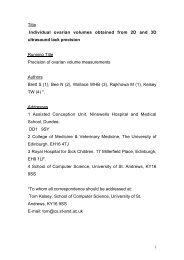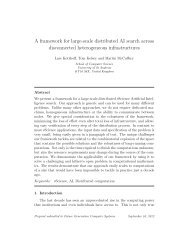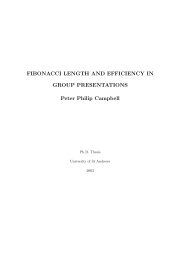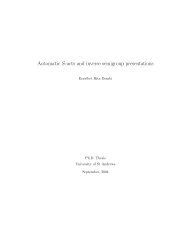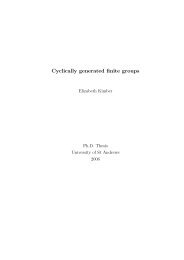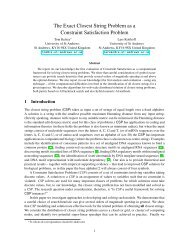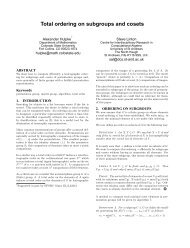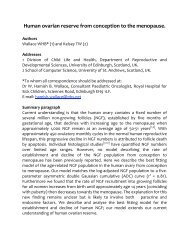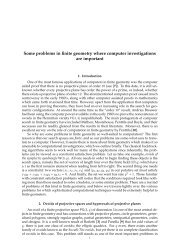The Casimir Effect - University of St Andrews
The Casimir Effect - University of St Andrews
The Casimir Effect - University of St Andrews
You also want an ePaper? Increase the reach of your titles
YUMPU automatically turns print PDFs into web optimized ePapers that Google loves.
<strong>The</strong> <strong>Casimir</strong> <strong>Effect</strong> <br />
Exploring and engineering the quantum vacuum <br />
Chun Xiong, Thomas Philbin, Tom Kelsey,<br />
Ulf Leonhardt and <strong>St</strong>eve Linton
<strong>Casimir</strong> forces <br />
Two mirrors<br />
<strong>Casimir</strong>, 1948:<br />
(Also van der Waals,<br />
London, Polder, …)<br />
Lamoreaux, 1997(!). First unambiguous<br />
demonstration <strong>of</strong> the <strong>Casimir</strong> force (sphere and plate).<br />
Distances ~ 100 nm, Forces ~ 100 pN.<br />
Capassso group, Harvard
<strong>Casimir</strong> force for realis:c materials – Lifshitz theory <br />
Two mirrors<br />
<strong>Casimir</strong>, 1948:<br />
For a~10nm, f ~ 1atmosphere.<br />
Lifschitz, 1955:<br />
A EE<br />
= r −1 E1<br />
r −1 E 2<br />
e 2aw −1,<br />
A BB<br />
= r −1 B1<br />
r −1 B 2<br />
e 2aw −1,<br />
€<br />
w = u 2 + υ 2 + κ 2 ,<br />
€<br />
r E1<br />
= µ 1(icκ)w − w 1<br />
µ 1<br />
(icκ)w + w 1<br />
,<br />
€<br />
w 1<br />
= u 2 + υ 2 + ε 1<br />
(icκ)µ 1<br />
(icκ)κ 2 .<br />
€<br />
r B1<br />
= − ε 1 (icκ)w − w 1<br />
ε 1<br />
(icκ)w + w 1<br />
,<br />
€<br />
€
<strong>Casimir</strong> force for realis:c materials – Lifshitz theory <br />
ω is a frequency associated with the oscilla:on <strong>of</strong> a classical dipole <br />
ε(ω) is the electric permiDvity <strong>of</strong> the material <br />
μ(ω) is the magne:c permeability <strong>of</strong> the material <br />
u, v and κ are also frequencies – in prac:ce we integrate over (what <br />
we guess are) realis:c finite ranges <br />
ω 2 = u 2 + v 2 + κ 2 , so ω describes a radius in (u,v,κ)‐space <br />
Calcula:ons are (rela:vely) straighNorward when we have uniform <br />
media, i.e. ε and μ are constant
<strong>Casimir</strong> forces and engineering <br />
<strong>Casimir</strong> forces are already being seen in<br />
MEMS (micro-electro-mechanicalsystems),<br />
causing malfunctions –<br />
‘stiction’.<br />
(Nature News Feature, 2007)<br />
<strong>Casimir</strong> forces will become even<br />
more significant at smaller scales.<br />
How large are the <strong>Casimir</strong> forces?<br />
How can they be manipulated?
Manipula:ng the <strong>Casimir</strong> force <br />
Dielectric sandwich<br />
Dzyaloshinskii, Lifshitz and Pitaevskii Adv. Phys. 10 (1961) 165<br />
Repulsive force if ε 1<br />
< ε 2<br />
< ε 3<br />
in the relevant (imaginary) frequency range.<br />
€<br />
Munday, Capasso and Parsegian, Nature 457 (2009) 170
Manipula:ng the <strong>Casimir</strong> force <br />
Magnetic mirror<br />
Two mirrors<br />
Conventional/magnetic mirror<br />
f = cπ 2<br />
240a 4<br />
f = − 7cπ 2<br />
1920a 4<br />
Boyer, 1974<br />
€<br />
€<br />
Metamaterials<br />
Magnetic mirror now built,<br />
for narrow bandwidth<br />
Schwanecke et al. J. Op. A 9 (2007) L1
Quantum Levita:on <br />
Suppose one mirror in the <strong>Casimir</strong> cavity is a 500nm thick aluminium foil (much thicker<br />
than the optical skin depth).<br />
With a repulsive <strong>Casimir</strong> force, an effective separation a’ <strong>of</strong> around 500nm would<br />
balance the gravitational force on the foil.<br />
Force:<br />
<strong>The</strong> foil would levitate<br />
on vacuum fluctuations.<br />
Philbin & Leonhardt 2007
Challenge: intui:on versus Lifshitz theory
Moving media <br />
Simplest case<br />
(Also simplest model<br />
<strong>of</strong> a nanomachine)<br />
?<br />
What are the <strong>Casimir</strong> forces?<br />
How is the perpendicular<br />
force modified by the motion?<br />
What is the lateral force –<br />
“Quantum Friction”?<br />
Thirty years <strong>of</strong> contradictory claims on this problem.<br />
Agreement (almost) that there is quantum friction unless the plates are perfect mirrors.<br />
Barton (1996) found zero lateral force on the plates in a very simplified model.<br />
Authors disagree on the magnitude <strong>of</strong> the <strong>Casimir</strong> forces; most try approximations.<br />
Answer is a sum <strong>of</strong> contributions from modes with E– and B–polarizations. (Wrong.)
Lateral <strong>Casimir</strong> force? <br />
<strong>The</strong> moving plate is like a non-moving anisotropic plate.<br />
It is equivalent to a particular non-moving bi-anisotropic plate.<br />
Suppose we build such a bi-anisotropic plate. <strong>The</strong>n can<br />
there be a unidirectional lateral <strong>Casimir</strong> force on the plates?<br />
This would seem to allow the extraction<br />
<strong>of</strong> unlimited energy from the quantum vacuum.<br />
Lateral <strong>Casimir</strong> force – <strong>Casimir</strong> torque <br />
Two non-aligned birefringent crystals experience a torque<br />
that tries to align them.<br />
[Barash, Izv. Vyssh. Uchebn. Zaved., Radi<strong>of</strong>iz. 12 (1978) 1637]<br />
[Philbin and Leonhardt, Phys. Rev. A 78 (2008) 042107]
<strong>The</strong> <strong>Casimir</strong> forces <br />
[Philbin and Leonhardt, New J. Phys. 11, (2009) 033035]<br />
<strong>St</strong>ress tensor is diagonal: no quantum friction.<br />
xx–component <strong>of</strong> stress tensor gives perpendicular force per unit area on plates:<br />
A XY<br />
= r −1 X1<br />
r −1 Y 2<br />
e 2aw −1, X ,Y ∈ { E,B}.<br />
f = c<br />
4π 3<br />
∞<br />
∫<br />
dκ<br />
€<br />
0<br />
∞<br />
∫<br />
−∞<br />
∞ ⎡<br />
du ∫ dυ w A EE<br />
+ A<br />
⎢<br />
BB<br />
⎢<br />
−∞<br />
⎣ A EE<br />
A BB<br />
( ) 2 − A EB<br />
+ A BE<br />
( u 2 + υ 2 − iκuβ) 2 − A EB<br />
A BE<br />
w 2 υ 2 β 2<br />
( ) u 2 + υ 2 − iκuβ<br />
( )w 2 υ 2 β 2 ⎤<br />
⎥<br />
⎥ .<br />
⎦<br />
<strong>St</strong>atic result (1955):<br />
β = 0 :<br />
f = c<br />
4π 3<br />
∞<br />
∫<br />
0<br />
dκ<br />
∞<br />
∫<br />
−∞<br />
du<br />
∞<br />
∫<br />
−∞<br />
dυ w ( A −1 −1<br />
EE<br />
+ A BB ),<br />
For dielectrics, motion adds an attractive component to the force compared to static case.<br />
With a magnetic response this component due to the motion can be attractive or repulsive.<br />
€
<strong>Casimir</strong> forces for spheres and cylinders <br />
Boyer, 1968. <strong>Casimir</strong> stress on a perfectly conducting<br />
sphere is infinite.<br />
Further regularization: force is repulsive!<br />
No experiments. <strong>The</strong>orists not agreed on what’s going on.<br />
<strong>Casimir</strong> stress on a perfectly conducting cylinder<br />
also diverges.<br />
Further regularization: force attractive.
<strong>Casimir</strong> forces for non‐homogeneous media <br />
We chose to consider a new situation:<br />
QV <br />
ε 1 is homogeneous as before<br />
QV is the quantum vacuum<br />
x <br />
ε 2 varies with distance from the ε 1 boundary, becoming<br />
constant at the QV boundary<br />
Initially we considered exponential decay:<br />
ε 2 (x) = ae -bx<br />
Again, no experiments -- theorists not agreed on what’s going on.<br />
We are at, or beyond, the limits <strong>of</strong> Lifshitz theory.<br />
We are certainly beyond the limits <strong>of</strong> <strong>Casimir</strong> theory.
<strong>Casimir</strong> forces for non‐homogeneous media <br />
Using Lifshitz theory we<br />
found that the key<br />
component <strong>of</strong> the stress<br />
tensor gave an infinite value<br />
when integrated.<br />
Either we had made a<br />
mistake, or Lifshitz theory<br />
was not as general as<br />
supposed.<br />
We replicated our Maple<br />
results using Mathematica,<br />
suggesting a closer look at<br />
Lifshitz theory.
<strong>Casimir</strong> forces for non‐homogeneous media <br />
Further analysis gave an<br />
extension to Lifshitz theory<br />
that<br />
(i) gives the same results<br />
for previous models<br />
(ii) gives finite integrands<br />
in our case<br />
We can now calculate the<br />
<strong>Casimir</strong> force for the<br />
exponential decay model …<br />
… and, in principle, for any<br />
inhomogeneous model
<strong>Casimir</strong> forces for non‐homogeneous media <br />
<strong>The</strong> <strong>Casimir</strong> force is attractive close to the ε 1 boundary, then<br />
becomes negative.
Challenges for future research <br />
We have been opera:ng at the limits both <strong>of</strong> what can be computed symbolically <br />
and the exis:ng theory. <br />
80% symbolic computa:on, 20% numeric (say). <br />
We know that we have divergence at the boundaries for the exponen:al decay model. <br />
We know that we would not have divergence for a C ∞ model. <br />
All our op:ons for C n models appear to involve 80% numeric and 20% symbolic <br />
computa:on, roughly speaking. <br />
Moreover, <strong>Casimir</strong> forces are small, so numeric precision is vital. <br />
And we will need to solve large numbers <strong>of</strong> systems <strong>of</strong> BVP ODE’s <br />
(if I can work out how to linearise the second order BVPs) so HPC, grid, cloud, etc. <br />
possibili:es will need to be considered.
CuDng Edges <br />
We are working on the boundary <strong>of</strong> exis:ng theory – it may or may not be possible <br />
to design experiments that confirm or refute our hypotheses. <br />
We are working on the boundary <strong>of</strong> the symbolic/numeric computa:onal divide. <br />
And we are working with small (picoNewtons) forces, so the trade<strong>of</strong>fs are not in our <br />
favour. For example, small effects in the finite element analysis <strong>of</strong> aircraf wing design <br />
are unimportant: will this large effect result in something bad happening? <br />
<strong>St</strong>andard error analysis is meaningless if you can’t specify what an error is ‐ and, at the <br />
moment ‐ we have no idea. <br />
We are working on the boundary <strong>of</strong> sequen:al and grid/cloud/distributed/parallel <br />
computa:on. If we reduce x‐points and/or frequency step‐sizes, can we derive any <br />
meaning from our results? If we don’t, are our planned computa:ons tractable on <br />
exis:ng architectures?
<strong>Casimir</strong> forces: <br />
Interes:ng, important and very poorly understood



